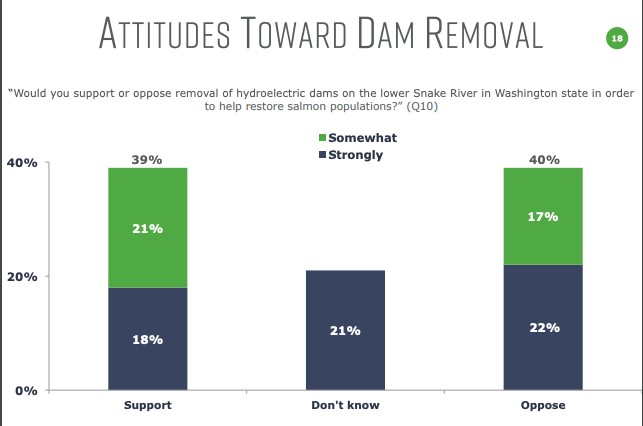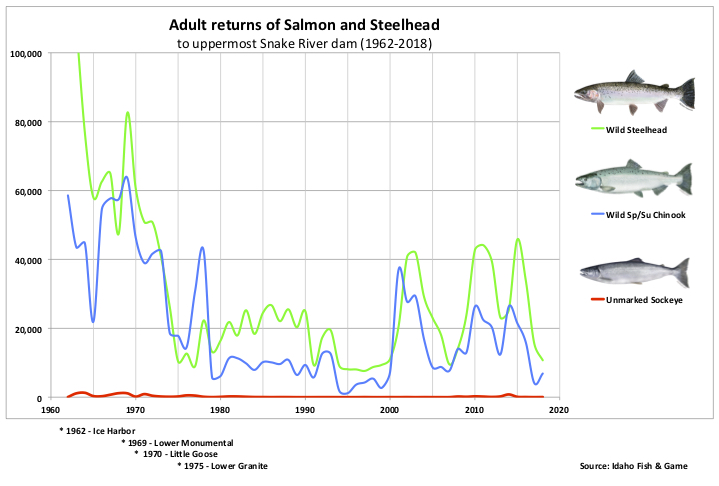forum
library
tutorial
contact

Poll: Washington Residents Care
About Salmon But Want to Keep Dams
by Annette Cary
Yakima Herald, December 18, 2019
|
the film forum library tutorial contact |

|
Poll: Washington Residents Care
by Annette Cary
|
"What we found is they (survey respondents) don't know very much and in fact, some of what they know is simply wrong.
Many people thought that the population of salmon on the Snake was declining, an in fact (?) it's actually increasing."
 The majority of people in Washington state are opposed to tearing down the lower Snake River dams and then paying higher electric rates because of the loss of hydropower, says the Washington Policy Center.
The majority of people in Washington state are opposed to tearing down the lower Snake River dams and then paying higher electric rates because of the loss of hydropower, says the Washington Policy Center.
It reached that conclusion in a statewide poll of 500 Washington residents in November that asked what people knew about the Snake River dams.
Not much, they found.
Then the group shared information about the benefits of the four dams -- renewable electricity from hydropower, irrigation for farms and shipping for harvested crops.
Participants in the poll also were told that federal and state scientists are not convinced that removing the dams would have the desired effect of boosting salmon and the orca populations that feed on chinook in the Puget Sound.
The Washington Policy Center, a nonprofit free-market group, believes that spending the limited resources available to help salmon populations, and by association orcas, by tearing down the dams would do more harm than good.
"When people know the facts about the Snake River dams, they support the CO2-free energy they produce and oppose wasting billions to destroy them," said Todd Myers, the center's environmental research director.
After hearing the center's information (bluefish contends this contained misinformation: runs have NOT increased over the past ten years, see graphic), the number of people being polled who still favored removing the dams dropped from 39 to 26 percent, and the number opposing removal increased from 40 to 58%.
Of those who supported removing the dams, 42% said they would only be willing to pay less than $10 a month because of higher electric rates due to less low-cost hydropower production.
POLL FINDS SUPPORT FOR SALMON
They do care about fish, however, Myers said.
Sixty-five percent of those responding to the poll said they would be willing to pay higher electric rates to improve fish passage at the dams. Again, 42% put the amount they were willing to pay at less than $10 a month.
The Washington Policy Center contrasts the results from an ECONorthwest study on the Snake River dams earlier in the year for Vulcan Inc., which oversees the business and philanthropic interests of the late Microsoft co-founder Paul Allen.
It concluded that the public highly values preserving salmon and that public benefits would justify removing the four hydrodams from Ice Harbor upriver to Lower Granite.
The ECONorthwest study concluded that it was worth $8.65 billion to the public to be rid of the dams, plus the more than $2 billion of actual economic factors such as removing the dams and increased electricity costs due to the loss of hydropower.
There are people for whom every $1 spent on higher utility bills is $1 that cannot be spent on rent or food, said state Sen. Sharon Brown, R-Kennewick, who spoke at a Tuesday's news conference to release the poll results.
Higher electricity costs can also make the difference in whether a business can hire another person who is desperate for a job, she said.
Before you can ask people how much they are willing to pay to tear down the Snake River dams, it is important to understand how much they know to judge the accuracy of the data collected, Myers said.
LITTLE KNOWLEDGE OF DAMS, SALMON

Few people responding to the Washington Policy Center study -- just 7% -- knew that there were four hydroelectric dams on the lower Snake River.
The majority of people taking the poll -- 65% -- said that salmon populations in the Snake River had decreased over the last decade. (bluefish: see graphic)
Numbers have increased overall, although that includes both hatchery and wild salmon, according to the Washington Policy Center.
But Myers believes that the key question is where to spend available money to help salmon.
Spending more than $1 billion to tear down the dams and hundreds of millions more a year for electricity would yield small environmental benefits.
The money would be better spent in the Puget Sound and along the coast where salmon are not recovering to benefit orcas, Myers said. The lowest estimate of tearing down the dams, without considering higher electricity costs, is equal to 20 years of current spending for salmon recovery in those areas, he said.
"You are basically rolling the dice on one thing and hoping it works," he said.
Support for tearing down the dams may have less to do with salmon than "a romantic attachment to wild and free rivers" by the environmental left, he said.
Related Pages:
It's Not Even Close: Economics says the Snake River Dams Should Go by Daniel Malarkey, Sightline Institute, 9/16/19
learn more on topics covered in the film
see the video
read the script
learn the songs
discussion forum
